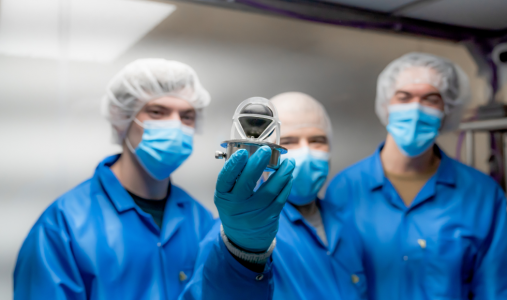Ask a McMaster expert: How does the NEUDOSE satellite work?

Andrei Hanu, co-Principal Investigator for the NEUDOSE satellite project, answers questions about McMaster’s first space mission.
BY Jesse Dorey
March 14, 2023
A team of over 150 students and researchers at McMaster have spent the last eight years building a satellite capable of measuring radiation levels in space.
Space radiation is dangerous and with humans aspiring to travel farther and spend longer in space, it’s important to understand the radiation they’re exposed to.
Andrei Hanu is the co-Principal Investigator of the NEUDOSE mission and a McMaster graduate. Here, he answers questions about how the team’s satellite works and explores the impact NEUDOSE will have on the world of space travel.
The NEUDOSE Story: Inside McMaster’s first space mission
What is NEUDOSE?
NEUDOSE — which stands for Neutron Dosimetry & Exploration (pronounced “new dose”) — is McMaster’s first satellite project.
NEUDOSE is intended to do two things. First, it’s meant to train undergraduate and graduate students in the full end-to-end process of designing a satellite, launching a satellite and operating a satellite in orbit.
Its secondary mission is a science objective. We’ve developed a special instrument to specifically measure in real time the types and levels of radiation that astronauts are exposed to. That instrument is on the NEUDOSE satellite, and when it is deployed into low Earth orbit, it will collect data and transmit it down to us at McMaster University.
How does NEUDOSE work?
The way NEUDOSE measures potentially dangerous radiation is by carrying a special instrument inside of it. This instrument is called a Charged & Neutral Particle Tissue Equivalent Proportional Counter (CNP-TECP). This is an instrument that we developed in our lab over the last five years, and it is actually two instruments in one.

The centre of the device is a TECP. This is a special kind of dosimeter that measures the dose from any kind of radiation that goes through it.
The outside of the device is another kind of detector called an anti-coincidence detector. This is what allows us to separate the dose from neutrons and the dose from charged particles into separate measurements.
All of these measurements are done in real time on the instrument. This data is then beamed down to the McMaster ground station for analysis.
How will the data collected by NEUDOSE be used?
After some initial analysis, the data we collect will be made available to the public. The intent of this is to produce maps of radiation in low Earth orbit.
These maps will be used by the Canadian Space Agency (CSA) to determine the dose astronauts will receive while they’re in low Earth orbit performing various activities on the International Space Station (ISS). This will help determine the radiation risk to astronauts.
Right now, this is a technology demonstration mission, but eventually NEUDOSE will be a standard radiation instrument for future missions to the Moon and eventually deep space.
How did you come up with the idea for the NEUDOSE project?
The NEUDOSE project started in October 2014.
During that time, I was a post-doctoral fellow at NASA Goddard Space Flight Center, and I had many colleagues that were developing satellite projects, an opportunity that was not available in Canada at that time.
The idea of being able to experience the process of designing an instrument, launching it and then eventually operating it in space was extremely exciting. And in visiting many of their labs, I got excited about the opportunity to do something like this ourselves.
I got motivated and decided to reach out to my former PhD advisor, Dr. Soo Hyun Byun at McMaster, and we started the project together in 2015.
What were the different stages of NEUDOSE?
The NEUDOSE satellite was developed in two parallel phases that merged over the last four years and eventually, now, over the last few months.
First was the actual concept development of the satellite. This is called a mission concept development stage, and it culminated with a mission concept review. This was held one year after we were awarded our grant. The CSA came, visited the team, listened to a presentation and gave us the go ahead that the mission concept was sound.
From there, we went through the preliminary design review, where we designed a high-level prototype of the satellite. It didn’t have all the hardware, so it was an attempt to make sure we were able to actually build the satellite. In this stage, we built small prototypes to ensure that each concept worked.
From there, we went to the critical design review, which essentially means building the components that will be launched into space.
And, finally, the construction process ended with the flight readiness review, which culminated with the handoff of the satellite to the CSA.
We’re extremely thankful to the Canadian Space Agency for giving us this opportunity and trusting us to build this mission.
But this is just the first mission. It won’t be the last.


